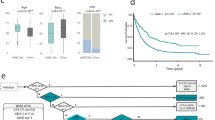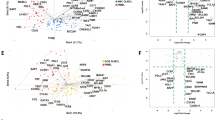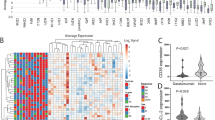Abstract
Precursor B-acute lymphoblastic leukemia (pB-ALL) is a heterogeneous disease and multiparameter flow cytometry, molecular genetics, and cytogenetic studies have all contributed to classification of subgroups with prognostic significance. Recently, gene expression microarray technology has been used to investigate lymphoblastic leukemias, demonstrating that known and novel pB-ALL subclasses can be separated on the basis of gene expression profiles. The strength of microarray technique lays in part in the multivariate nature of the expression data. We propose a parallel multiparametric approach based on immunophenotypic flow-cytometry expression data for the analysis of leukemia patients. Specifically, we tested the potential of this approach on a data set of 145 samples of pediatric pB-ALL that included 46 samples positive for mixed lineage leukemia (MLL) translocations (MLL+) and 99 control pB-ALLs, negative for this translocation (MLL−). The expression levels of 16 marker proteins have been monitored by four-color flow cytometry using a standardized diagnostic panel of antibodies. The protein expression database has been then analyzed using those univariate and multivariate computational techniques normally applied to mine and model large microarray data sets. Marker protein expression profiling not only allowed separating pB-ALL cases with an MLL rearrangement from other ALLs, but also demonstrates that MLL+ leukemias constitute a heterogeneous group in which MLL/AF4 leukemias represent a homogenous subclass described by a specific expression fingerprint.
This is a preview of subscription content, access via your institution
Access options
Subscribe to this journal
Receive 12 print issues and online access
$259.00 per year
only $21.58 per issue
Buy this article
- Purchase on Springer Link
- Instant access to full article PDF
Prices may be subject to local taxes which are calculated during checkout




Similar content being viewed by others
References
Rubnitz JW, Look AT . Molecular genetics of childhood leukemias. J Pediatr Hematol Oncol 1998; 20: 1–11.
Ferrando AA, Look AT . Clinical implications of recurring chromosomal and associated molecular abnormalities in acute lymphoblastic leukemia. Semin Hematol 2000; 37: 381–395.
Pui C-H, Evans WE . Acute lymphoblastic leukemia. N Engl J Med 1998;339:605–615.
Pui C-H . Acute lymphoblastic leukemia in children. Curr Opin Oncol 2000; 12: 3–12.
Forestier E, Johansson B, Gustafsson G, Borgstrom G, Kerndrup G, Johansson J et al. Prognostic impact of karyotypic findings in childhood acute lymphoblastic leukaemia: a Nordic series comparing two treatment periods. Br J Haematol 2000; 110: 147–153.
Rubnitz JE, Behm FG, Pui C-H, Evans WE, Reling MV, Raimondi SC et al. Genetic studies of childhood acute lymphoblastic leukemia with emphasis on p16, MLL, and ETV6 gene abnormalities: results of St Jude Total Therapy Study XII. Leukemia 1997; 11: 1201–1206.
Gaynon PS, Crotty ML, Sather HN, Bostrom BC, Nachman JB, Steinherz PG et al. Expression of BCR–ABL, E2A–PBX1, and MLL–AF4 fusion transcripts in newly diagnosed children with acute lymphoblastic leukemia: a Children's Cancer Group initiative. Leuk Lymphomaemia 1997; 26: 57–65.
Schlieben S, Borkhardt A, Reinisch I, Ritterbach J, Janssen JW, Ratei R et al. Kabisch incidence and clinical outcome of children with BCR/ABL-positive acute lymphoblastic leukemia (ALL). A prospective RT-PCR study based on 673 patients enrolled in the German pediatric multicenter therapy trials ALL-BFM-90 and CoALL-05-92. Leukemia 1996; 10: 957–963.
McLean TW, Ringold S, Neuberg D, Stegmaier K, Tantravahi R, Ritz J et al. TEL/AML1 dimerizes and is associated with a favorable outcome in childhood acute lymphoblastic leukemia. Blood 1996; 88: 4252–4258.
Borkhardt A, Cazzaniga G, Viehmann S, Valsecchi MG, Ludwig WD, Burci L et al. Incidence and clinical relevance of TEL/AML1 fusion genes in children with acute lymphoblastic leukemia enrolled in the German and Italian multicenter therapy trials. Blood 1997; 90: 571–577.
Bene MC, Castoldi G, Knapp W, Ludwig WD, Matutes E, Orfao A et al. Proposal for the immunological classification of acute leukemias. European Group for the immunological Characterization of Leukemias (EGIL). Leukemia 1995; 9: 1783–1786.
Braylan RC, Borowitz MJ, Davis BH, Stelzer GT, Stewart CC . US–Canadian consensus recommendations on the immunophenotypic analysis of hematologic neoplasia by flow cytometry. Cytometry 1997; 30: 213.
Orfao A, Schmitz G, Brando B, Ruiz-Arguelles A, Basso G, Brayland R et al. Clinically useful information provided by the flow cytometric immunophenotyping of hematological malignancies: current status and future directions. Clin Chem 1999; 45: 1708–1717.
Armstrong SA, Staunton JE, Silverman LB, Pieters R, den Boer ML, Minden MD et al. MLL translocations specify a distinct gene expression profile that distinguishes a unique leukemia. Nat Genet 2002; 30: 41–47.
Yeoh E-J, Ross ME, Shutleff SA, Williams WK, Patel D, Mahfouz R et al. Classification, subtype discovery, and prediction of outcome in pediatric acute lymphoblastic leukemia by gene expression profiling. Cancer Cell 2002; 1: 133–143.
De Zen L, Orfao A, Cazzaniga G, Masiero L, Cocito MG, Spinelli M et al. Quantitative multiparametric immunophenotyping in acute lymphoblastic leukemia: correlation with specific genotype. I. ETV6/AML1 ALLs identification. Leukemia 2000; 14: 1225–1231.
Basso G, Buldini B, De Zen L, Orfao A . New methodologic approaches for immunophenotyping acute leukemias. Heamatologica 2001; 86: 675–692.
Jackson JE . PCA with more than two variables. In: Jin Jackson JE (ed). A User's Guide to Principal Components Analysis New York: John Wiley & Sons, Inc., 1991, pp 26–62.
Massart DL, Vandegiste BGM, Deming SN, Michotte Y, Kaufman L . Supervised pattern recognition. In: Vandegiste BGM, Kaufman L. (eds). Chemometrics: A Textbook. Amsterdam, The Netherlands: Elsevier, 1988, pp 385–414.
Behm FG, Smith FO, Raimondi SC, Pui C-H, Bernstein ID . Human homologue of rat chondroitin sulfate proteoglycan, NG2, detected by monoclonal antibody 7.1, identifies childhood acute lymphoblastic leukemias with t(4;11)(q21;q23) or t(11;19)(q23;p13) and MLL gene rearrangements. Blood 1996; 87: 1134–1139.
Smith FO, Rauch C, Williams DE, March CJ, Arthur D, Hilden J et al. The human homologue of rat NG2, a chondroitin sulfate proteoglycan, is not expressed on the cell surface of normal hematopoietic cells but is expressed by acute myeloid leukemia blasts from poor-prognosis patients with abnormalities of chromosome band 11q23. Blood 1996; 87: 1123–1133.
Hilden JM, Smith FO, Frestedt JL, McGlennen R, Howells WB, Sorensen PH et al. MLL gene rearrangement, cytogenetic 11q23, abnormalities and expression of the NG2 molecule in infant acute myeloid leukemia. Blood 1997; 89: 3801–3805.
Wuchter C, Harbott J, Schoch C, Schnittger S, Borkhardt A, Karawajew L et al. Detection of acute leukemia cells with mixed lineage leukemia (MLL) gene rearrangements by flow cytometry using monoclonal antibody 7.1. Leukemia 2000;14:1232–1238.
Pui C-H, Frankel LS, Carroll AJ, Raimondi SC, Shuster JJ, Head DR et al. Clinical characteristics and treatment outcome of childhood acute lymphoblastic leukemia with the t(4;11)(q21;p23): a collaborative study of 40 cases. Blood 1991; 77: 440–447.
Pui C-H . Acute leukemias with the t(4;11)(q21;p23). Leukemia Lymphoma 1992; 7: 173–179.
Johansson B, Moorman AV, Haas OA, Watmore AE, Cheung KL, Swanton S et al. Hematologic malignancies with t(4;11)(q21;q23) -a cytogenetic, morphologic, immunophenotypic and clinical study of 183 cases. Leukemia 1998; 12: 779–787.
Pui C-H, Carroll AJ, Raimondi SC, Shuster JJ, Crist WM, Pullen DJ . Childhood acute lymphoblastic leukemia with the t(4;11)(q21;q23): an update (letter). Blood 1994; 83: 2384–2385.
Rubnitz JE, Camitta BM, Mahmoud H, Raimondi SC, Carroll AJ, Borowitz MJ et al. Childhood acute lymphoblastic leukemia with the MLL-ENL fusion and t(11;19)(q23;p13.3) translocation. J Clin Oncol 1999; 17: 191–196.
Maynadie M, Picard F, Husson B, Chatelain B, Cornet Y, Le Roux G et al. Immunophenotypic clustering of myelodysplastic syndromes. Blood 2002; 100: 2349–2356.
Hrusak O, Porwit-MacDonald A . Antigen expression patterns reflecting genotype of acute leukemias. Leukemia 2002; 16: 1233–1258.
Tien H-F, Wang C-H, Lee F-Y, Liu MC, Chuang SM, Chen YC et al. Cytogenetic study of acute lymphoblastic leukemia and its correlation with immunophenotype and genotype. Cancer Genet Cytogenet 1992; 59: 191–198.
Tabernero MD, Bortoluci AM, Alaejos I, Lopez-Berges MC, Rasillo A, Garcia-Sanz R et al. Adult precursor B-ALL with BCR/ABL gene rearrangement displays a unique immunophenotype based on the pattern of CD10, CD34, CD13 and CD38 expression. Leukemia 2001; 15: 406–414.
Pui C-H, Behm FG, Downing JR, Hancock ML, Shurtleff SA, Ribeiro RC et al. 11q23/MLL rearrangement confers a poor prognosis in infants with acute lymphoblastic leukemia. J Clin Oncol 1994; 12: 909–915.
Heerema NA, Arthur DC, Sather H, Albo V, Feusner J, Lange BJ et al. Cytogenetic features of infants less than 12 months of age at diagnosis of acute lymphoblastic leukemia: Impact of the 11q23 breakpoint on outcome: A report of the Childrens Cancer Group. Blood 1994; 83: 2274–2284.
Cimino G, Rapanotti MC, Rivolta A, Lo Coco F, D'Arcangelo E, Rondelli R et al. Prognostic relevance of ALL-1 gene rearrangement in infant acute leukemias. Leukemia 1995; 9: 391–395.
Acknowledgements
This work was supported by Fondazione Città della Speranza, CNR, d MURST ex. 40 and 60%. We gratefully acknowledge Professor A Orfao for his critical advice and Professor A Biondi, Dr E Frascella and Dr A Leszl for genetic characterization of leukemia samples.
Author information
Authors and Affiliations
Rights and permissions
About this article
Cite this article
Zen, L., Bicciato, S., Kronnie, G. et al. Computational analysis of flow-cytometry antigen expression profiles in childhood acute lymphoblastic leukemia: an MLL/AF4 identification. Leukemia 17, 1557–1565 (2003). https://doi.org/10.1038/sj.leu.2403013
Received:
Accepted:
Published:
Issue Date:
DOI: https://doi.org/10.1038/sj.leu.2403013
Keywords
This article is cited by
-
Use of Direct Gradient Analysis to Uncover Biological Hypotheses in 16S Survey Data and Beyond
Scientific Reports (2012)
-
MLL rearrangements in pediatric acute lymphoblastic and myeloblastic leukemias: MLL specific and lineage specific signatures
BMC Medical Genomics (2009)
-
Validation of NG2 antigen in identifying BP-ALL patients with MLL rearrangements using qualitative and quantitative flow cytometry: a prospective study
Leukemia (2008)
-
Discriminant function analysis as decision support system for the diagnosis of acute leukemia with a minimal four color screening panel and multiparameter flow cytometry immunophenotyping
Leukemia (2007)
-
Automated in-silico detection of cell populations in flow cytometry readouts and its application to leukemia disease monitoring
BMC Bioinformatics (2006)



